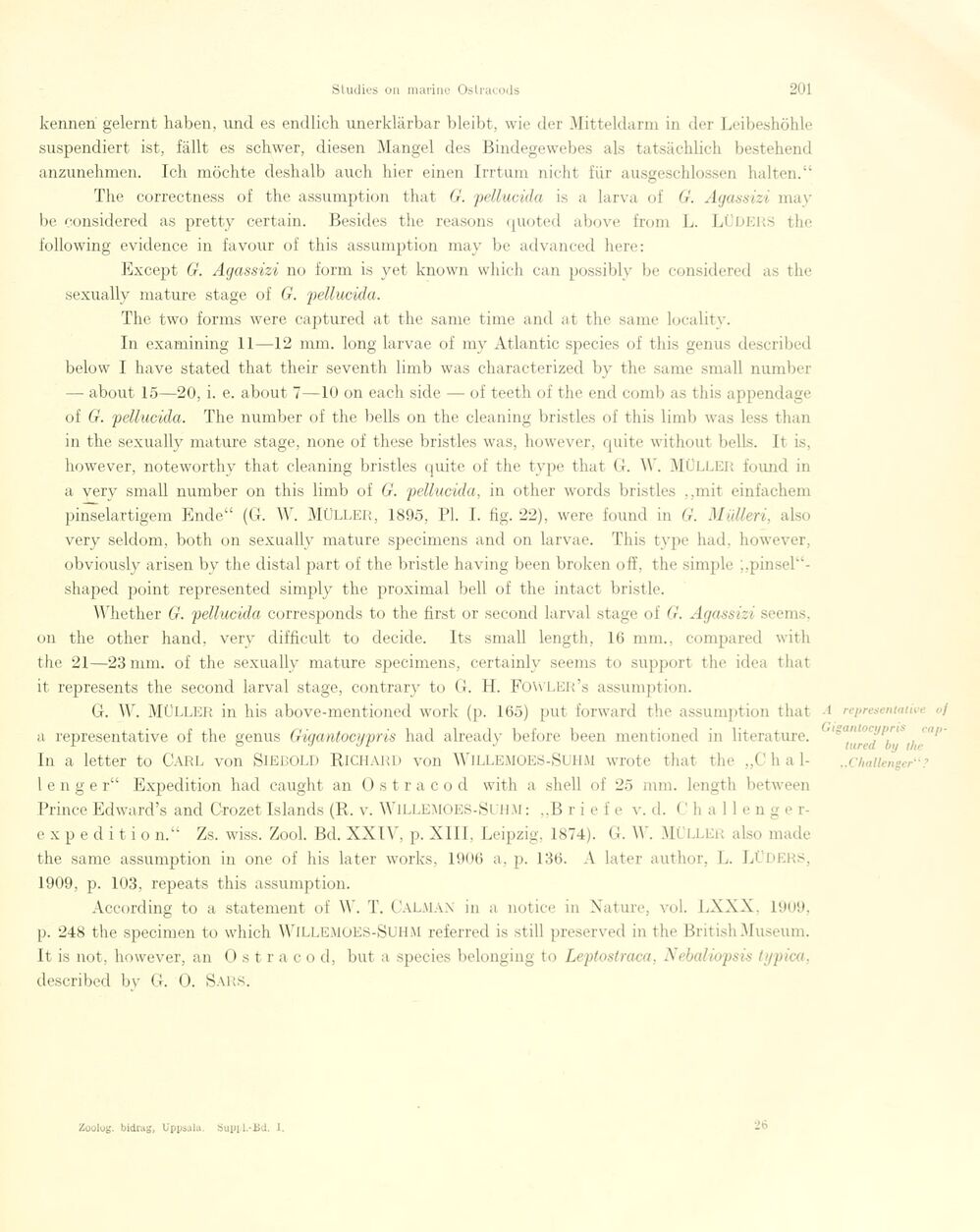
Full resolution (JPEG) - On this page / på denna sida - Sidor ...

<< prev. page << föreg. sida << >> nästa sida >> next page >>
Below is the raw OCR text
from the above scanned image.
Do you see an error? Proofread the page now!
Här nedan syns maskintolkade texten från faksimilbilden ovan.
Ser du något fel? Korrekturläs sidan nu!
This page has never been proofread. / Denna sida har aldrig korrekturlästs.
kennen gelernt haben, und es endlich unerklärbar bleibt, wie der Mitteldarm in der Leibeshöhle
suspendiert ist, fällt es schwer, diesen Mangel des Bindegewebes als tatsächlich bestehend
anzunehmen. Ich möchte deshalb auch hier einen Irrtum nicht für ausgeschlossen halten.“
The correctness of the assumption that G. pellucida is a larva of G. Acjassizi may
be çonsidered as pretty certain. Besides the reasons qiioted above from L. LÜDERS the
following evidence in favour of this assumption may be advaneed here:
Except G. Acjassizi no form is yet known whieh can possibly be çonsidered as the
sexually mature stage of G. pellucida.
The two forms were captured at the same time and at the same locality.
In examining 11—12 mm. long larvae of my Atlantic species of this genus described
below I have stated that their seventh limb was characterized by the same small number
—- about 15—20, i. e. about 7—10 on each side — of teeth of the end comb as this appendage
of G. pellucida. The number of the bells on the cleaning bristles of this limb was less than
in the sexually mature stage, none of these bristles was, however, quite without bells. It is,
however, noteworthy that cleaning bristles quite of the type that G. W. MÜLLER foimd in
a very small number on this limb of G. pellucida, in other words bristles ,,mit einfachem
pinselartigem Ende“ (G. W. MÜLLER, 1895, Pl. I. fig. 22), were foimd in G. Mulleri, also
very seldom, both on sexually mature specimens and on larvae. This type had. however,
obviously arisen by the distal part of the bristle ha ving been broken off, the simple
„pinsel“-shaped point represented simply the proximal bell of the intact bristle.
Whether G. pellucida corresponds to the first or second larval stage of G. Acjassizi seems,
on the other hånd, very difficult to decide. Its small length, 16 mm., compared with
the 21—23 mm. of the sexually mature specimens, certainlv seems to support the idea that
it represents the second larval stage, contrary to G. H. FOWLER’s assumption.
G. W. MÜLLER in his above-mentioned work (p. 165) put forward the assumption that
a representative of the genus Gijantocypris had already before been mentioned in literature.
In a letter to CARL von SlEBOLD RICHARD von WlLLEMOES-SUHAl wrote that the „C h a
1-lenge r“ Expedition had caught an Ostrâ cod with a shell of 25 mm. length between
Prince Edward’s and Grozet Islands (R. v. WlLLEMOES-SüILM : ,,B riefe v. d. C h a 11 e n g e
r-expeditio n.“ Zs. wiss. Zool. Bd. XXIV, p. XIII, Leipzig, 1874). G. W. MÜLLER also made
the same assumption in one of his later works, 1906 a, p. 136. A later author, L. LÜDERS,
1909, p. 103, repeats this assumption.
According to a statement of W. T. CaLMAN in a notice in Nature, vol. LXXX. 1909,
p. 248 the specimen to which WlLLEiMOES-SUHM referred is still preserved in the British Museum.
It is not, however, an O s t r a c o d, but a species belonging to Leptostraca. Nebaliopsis typica.
described by G. 0. Sars.
A representative uj
Gigantocypris
captured by the
..Challenger’’ ?
Zoolog, bidrag, Uppsala. Suppl.-Bd. 1.
26
<< prev. page << föreg. sida << >> nästa sida >> next page >>